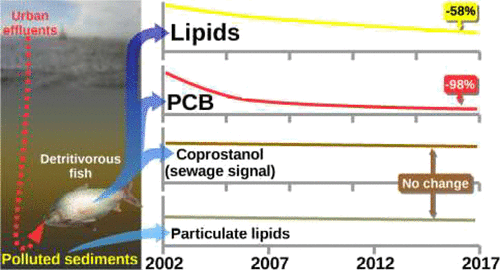当前位置:
X-MOL 学术
›
Environ. Sci. Technol.
›
论文详情
Our official English website, www.x-mol.net, welcomes your
feedback! (Note: you will need to create a separate account there.)
Metabolic Disrupting Effects of Polychlorinated Biphenyls Revealed by Long-Term Temporal Variations of Lipids in Detritivorous Fish from the Rio de la Plata Basin
Environmental Science & Technology ( IF 10.8 ) Pub Date : 2021-09-23 , DOI: 10.1021/acs.est.1c02299 Eric D Speranza 1, 2 , Leandro M Tatone 1, 2 , Maria C Migoya 1, 2 , Juan C Colombo 1, 3
Environmental Science & Technology ( IF 10.8 ) Pub Date : 2021-09-23 , DOI: 10.1021/acs.est.1c02299 Eric D Speranza 1, 2 , Leandro M Tatone 1, 2 , Maria C Migoya 1, 2 , Juan C Colombo 1, 3
Affiliation

|
The long-term covariation (2002–2017) of lipids, polychlorinated biphenyls (PCBs), and sewage tracers was studied in the detritivorous fish (Prochilodus lineatus) and settling detritus from the Rio de la Plata. Fatty fish from polluted Buenos Aires area (BA) exhibited a significant decrease of muscle lipids (71 ± 12 to 29 ± 8.6% dry weight; p < 0.0001), triglycerides (94 to 85%, p < 0.001), and 18 carbon fatty acids (18C-FA: 59 ± 4.8 to 48 ± 1.4%; p < 0.01), reflecting a reduction of lipid accumulation, largely triglycerides enriched in 18C-FA, with a concomitant ∼20-times decline of PCBs (∼20 to >1 μg g–1 dw). The 2017 individuals of the BA series converged with leaner and more pristine northern fish (N), which showed no significant temporal variation (20 ± 10% lipids, 67 ± 8.7% triglycerides, 41 ± 8.1% 18C-FA, and 0.22 ± 0.42 μg g–1 dw PCB). In contrast, the fecal sterol tracer coprostanol remained abnormally higher in BA fish muscle with no significant temporal trend (120 ± 102 vs 6.6 ± 10 μg g–1 dw or 4.4 ± 2.8 vs 0.63 ± 1.2% sterols at N). The same pattern was observed in BA settling detritus, i.e., a temporal decrease of PCBs with high, stable coprostanol concentrations denoting sustained sewage inputs, while northern detritus was enriched in plant sterols. This long-term covariation of lipids and PCBs in fish muscle from polluted BA converging with more pristine and homogeneous northern specimens while maintaining a sewage-derived diet provides rare field evidence of the declining effect of PCBs controlling the temporal variation of muscular lipids in fish.
中文翻译:

拉普拉塔河盆地食腐鱼类脂质的长期时间变化揭示了多氯联苯的代谢干扰作用
在拉普拉塔河的碎屑鱼 ( Prochilodus lineatus ) 和沉淀碎屑中研究了脂质、多氯联苯 (PCB) 和污水示踪剂的长期协变 (2002-2017) 。来自受污染的布宜诺斯艾利斯地区 (BA) 的脂肪鱼表现出肌肉脂质(干重 71 ± 12 至 29 ± 8.6%;p < 0.0001)、甘油三酯(94 至 85%,p < 0.001)和 18 碳脂肪的显着降低酸(18C-FA:59 ± 4.8 至 48 ± 1.4%;p < 0.01),反映脂质积累减少,主要是富含 18C-FA 的甘油三酯,同时 PCBs 减少约 20 倍(约 20 至 > 1 微克克–1dw)。BA 系列的 2017 个体与更瘦和更原始的北方鱼(N)汇合,没有显示出显着的时间变化(20 ± 10% 脂质、67 ± 8.7% 甘油三酯、41 ± 8.1% 18C-FA 和 0.22 ± 0.42 μg g –1 dw PCB)。相比之下,BA 鱼肌肉中粪便甾醇示踪剂粪前列醇仍然异常高,没有显着的时间趋势(120 ± 102 vs 6.6 ± 10 μg g –1dw 或 4.4 ± 2.8 vs 0.63 ± 1.2% N 甾醇)。在 BA 沉降碎屑中观察到相同的模式,即,具有高、稳定的粪前列醇浓度的多氯联苯随时间减少,表示持续的污水输入,而北部碎屑富含植物甾醇。来自受污染的 BA 的鱼肌肉中脂质和 PCB 的这种长期协变与更原始和均匀的北方标本会聚,同时保持源自污水的饮食,这提供了罕见的现场证据,证明 PCB 控制鱼类肌肉脂质的时间变化的效果下降。
更新日期:2021-10-06
中文翻译:

拉普拉塔河盆地食腐鱼类脂质的长期时间变化揭示了多氯联苯的代谢干扰作用
在拉普拉塔河的碎屑鱼 ( Prochilodus lineatus ) 和沉淀碎屑中研究了脂质、多氯联苯 (PCB) 和污水示踪剂的长期协变 (2002-2017) 。来自受污染的布宜诺斯艾利斯地区 (BA) 的脂肪鱼表现出肌肉脂质(干重 71 ± 12 至 29 ± 8.6%;p < 0.0001)、甘油三酯(94 至 85%,p < 0.001)和 18 碳脂肪的显着降低酸(18C-FA:59 ± 4.8 至 48 ± 1.4%;p < 0.01),反映脂质积累减少,主要是富含 18C-FA 的甘油三酯,同时 PCBs 减少约 20 倍(约 20 至 > 1 微克克–1dw)。BA 系列的 2017 个体与更瘦和更原始的北方鱼(N)汇合,没有显示出显着的时间变化(20 ± 10% 脂质、67 ± 8.7% 甘油三酯、41 ± 8.1% 18C-FA 和 0.22 ± 0.42 μg g –1 dw PCB)。相比之下,BA 鱼肌肉中粪便甾醇示踪剂粪前列醇仍然异常高,没有显着的时间趋势(120 ± 102 vs 6.6 ± 10 μg g –1dw 或 4.4 ± 2.8 vs 0.63 ± 1.2% N 甾醇)。在 BA 沉降碎屑中观察到相同的模式,即,具有高、稳定的粪前列醇浓度的多氯联苯随时间减少,表示持续的污水输入,而北部碎屑富含植物甾醇。来自受污染的 BA 的鱼肌肉中脂质和 PCB 的这种长期协变与更原始和均匀的北方标本会聚,同时保持源自污水的饮食,这提供了罕见的现场证据,证明 PCB 控制鱼类肌肉脂质的时间变化的效果下降。











































 京公网安备 11010802027423号
京公网安备 11010802027423号